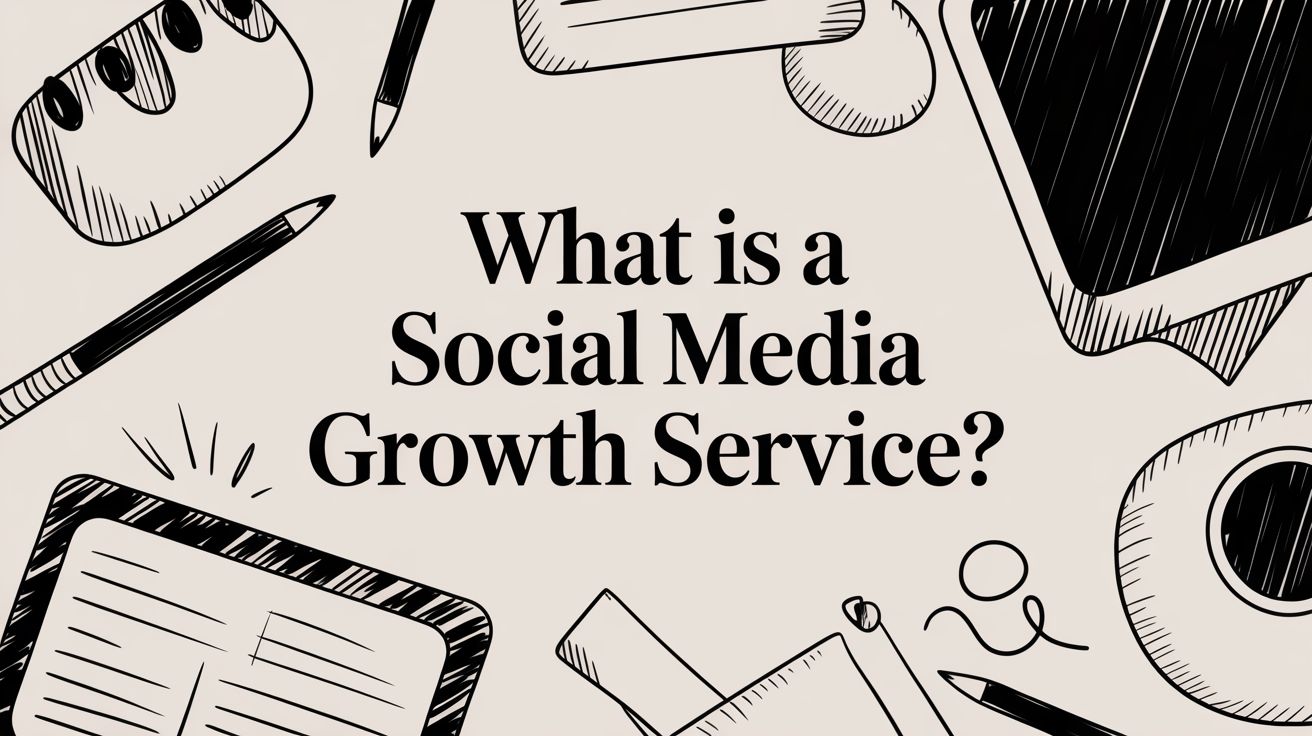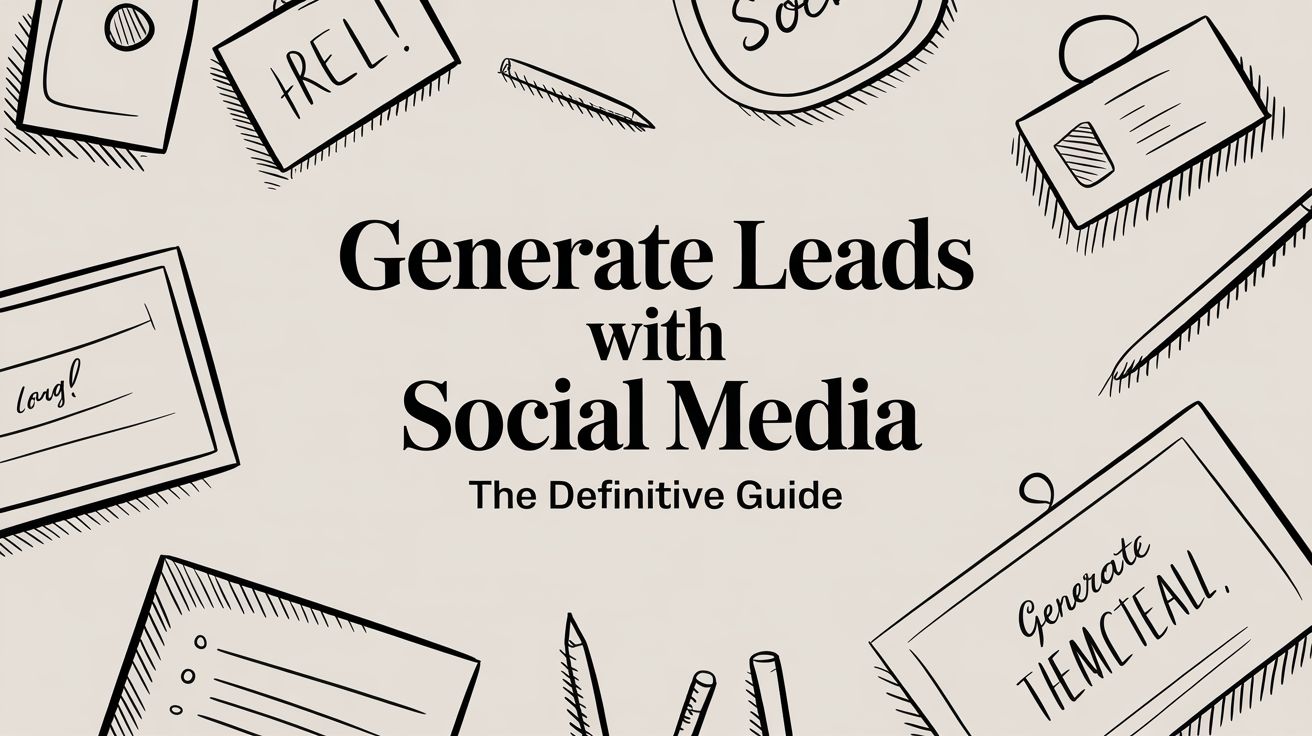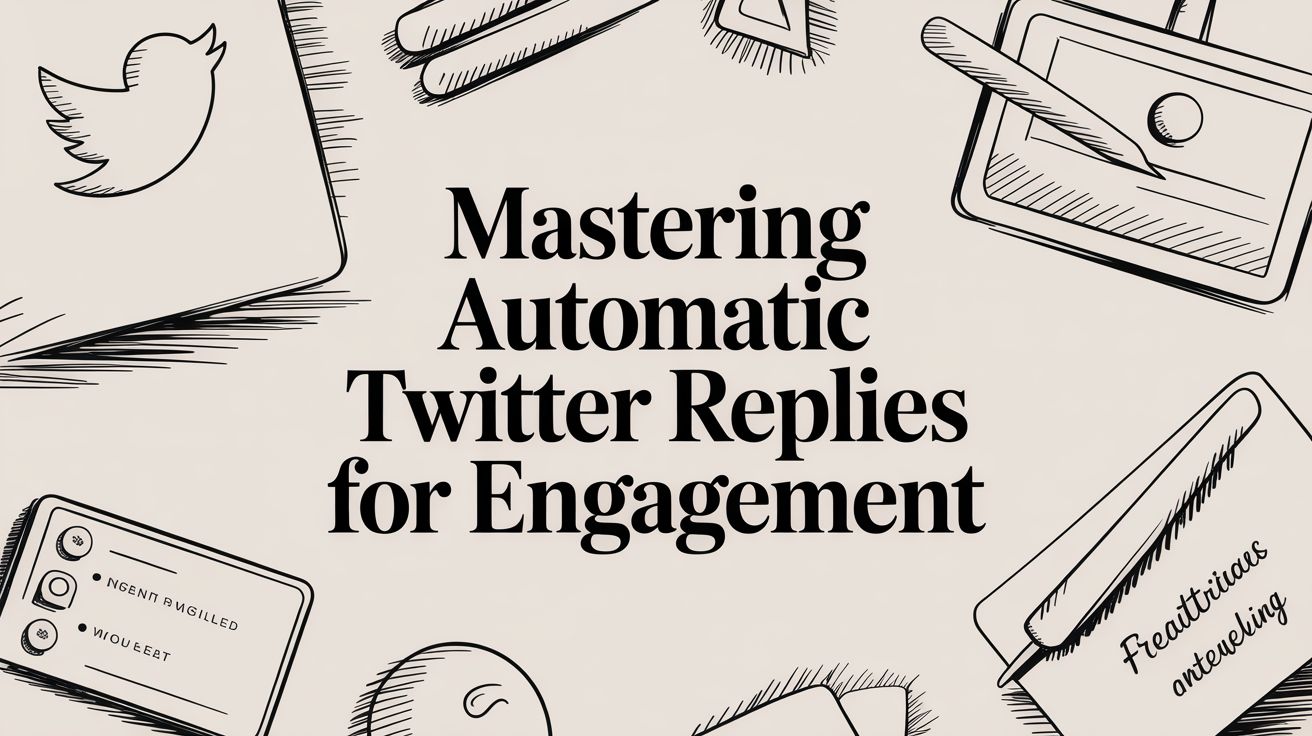Word-of-mouth marketing (WOMM) is really just a fancy term for something we all do every day: telling people about things we love. It’s the original marketing channel. Think about the last time a friend raved about a new restaurant or a colleague couldn't stop talking about a piece of software that saved them hours of work. That’s it. That’s word-of-mouth.
It’s about turning your happy customers into your most powerful advocates, who then go on to recommend your product or service to their network.
The Foundation of Authentic Marketing

Before we get into specific tactics, let's be clear on what word of mouth marketing actually is. It’s not about finding a clever gimmick or launching a viral campaign. At its heart, it’s about creating a product and an experience so good that people can’t help but talk about it. This creates a level of trust and credibility that no amount of ad spend can ever buy.
We're all bombarded with ads every single day. So, when a recommendation comes from a person we actually know and trust, it cuts right through the noise. This isn't just a hunch—the numbers are staggering. Word-of-mouth marketing is responsible for an estimated $6 trillion in sales annually around the globe. And maybe even more telling, 92% of people trust recommendations from people they know far more than any other form of advertising. You can discover more insights on WOMM's impact to see just how significant this is.
For SaaS and B2B companies, this is gold. Why? Because those buying decisions are rarely impulsive; they’re built on research, peer validation, and social proof. A recommendation from a fellow professional is often the deciding factor.
WOMM vs. Traditional Advertising
So, what really sets word-of-mouth apart from old-school advertising? It comes down to one thing: trust.
Traditional advertising tells you a product is great. Word-of-mouth shows you it’s great through the genuine stories and experiences of real people. That’s a massive difference, and it’s the key to building real, lasting brand loyalty.
To make this crystal clear, here’s a quick breakdown of how the two stack up.
Word of Mouth Marketing At a Glance
This table gives you a snapshot of the core differences between WOMM and paid advertising, highlighting why one builds authentic connection while the other simply broadcasts a message.
| Attribute | Word of Mouth Marketing (WOMM) | Traditional Advertising |
|---|---|---|
| Source | Trusted friends, family, or peers | Paid media (TV, print, digital ads) |
| Credibility | High, perceived as unbiased | Low, perceived as biased |
| Reach | Organic and targeted within networks | Broad and often untargeted |
| Cost | Low to minimal financial investment | High cost for media placement |
| Longevity | Lasting impact through relationships | Short-term impact, ends with campaign |
When you boil it all down, WOMM wins because it’s real. It transforms your happiest customers into a volunteer army of marketers, creating a powerful, compounding effect that is both incredibly persuasive and surprisingly cost-effective.
Exploring the Three Types of WOMM
Word-of-mouth marketing isn't a one-size-fits-all strategy. It's really a spectrum of conversations, from totally spontaneous chatter to carefully guided campaigns. If you want to make it work for you, you first need to understand the different flavors.
Each type has its own triggers and plays a different role, but they all circle back to the same goal: turning happy customers into your best marketing channel.
Let's break down the three main ways this happens.
1. Organic WOMM: The Unprompted Praise
This is the holy grail. Organic WOMM happens all on its own when a customer is so blown away by your product or service that they can't help but tell people about it. There’s no incentive, no ask—just pure, unprompted enthusiasm.
It’s the most trusted and authentic form of marketing because it’s a genuine reaction to a great experience.
Think about the last time a SaaS tool made your life so much easier that you immediately Slacked your team, "You have to see this." That's organic WOMM. Dropbox's explosive early growth is a perfect example; people shared it because it was a genuinely better way to handle files.
2. Amplified WOMM: Nudging the Conversation Along
While you can't force organic buzz, you don't have to just sit around and hope for it. Amplified WOMM is all about intentionally encouraging and speeding up these conversations. You’re not manufacturing the praise, you're just making it easier for happy customers to share it.
A few classic examples of amplified WOMM in action include:
- Referral Programs: Giving customers a little something—like a discount or account credit—for bringing in a new user. Tesla did this brilliantly, rewarding its biggest fans with exclusive perks for referrals.
- Customer Reviews: Simply asking satisfied clients to leave a review on sites like G2, Capterra, or Google can make a huge difference.
- User-Generated Content (UGC): Running a campaign that encourages people to post photos or videos with a specific hashtag.
The goal here is to facilitate sharing, not fake it. You’re giving your biggest fans a megaphone by building on the satisfaction they already feel.
3. Influencer-Driven WOMM: Tapping into Trusted Voices
Finally, we have Influencer-Driven WOMM. This involves partnering with people who have already built credibility and a loyal following within a specific niche. We're not just talking about massive celebrity endorsements; this is often more powerful with industry experts or micro-influencers whose followers genuinely trust their recommendations.
This approach works by introducing your brand to a new audience through a voice they already know and respect. For a deeper dive, it's worth understanding what brand ambassadors are and how they operate.
Essentially, you're borrowing the influencer's hard-earned credibility to get your message in front of an audience that’s ready to listen.
Why B2B and SaaS Companies Run on Trust
In the consumer world, an impulse buy might set you back the price of a fancy coffee. But in the world of B2B and SaaS, the stakes are completely different. Decisions often involve tens of thousands of dollars, sign-off from multiple departments, and long-term contracts that can shape a company's future.
Here, trust isn't just a nice-to-have; it's the currency you trade in. Choosing a new software platform isn't like buying a t-shirt. It's a huge commitment of time, money, and operational energy. A bad call can have serious ripple effects, which is why buyers lean so heavily on the experiences of people they know and respect. This is exactly why word-of-mouth isn't just another marketing tactic—it's a fundamental growth engine.
The Ultimate Sales Cycle Shortcut
Think about it. A single, honest recommendation from a trusted peer can do what months of cold calls and slick sales demos never could. It instantly injects a level of credibility that advertising can only dream of.
When a colleague you trust says, “We use this tool, and it’s been a game-changer,” it cuts right through the noise and skepticism. Suddenly, you're not just another vendor—you're a solution worth serious consideration. This is how companies like Slack and HubSpot first took off. They didn't just sell to businesses; they created an experience so good that employees became their best salespeople. One person would start using the tool, tell their team how great it was, and it would spread like wildfire through the company, all driven by genuine user love.
Word-of-mouth in B2B doesn’t just influence a purchase; it often creates the opportunity in the first place. A recommendation puts you on a shortlist that ad spend alone could never access.
Building a Defensible Growth Engine
The impact goes way beyond just speeding up the sales process. Companies that truly nail word-of-mouth see a massive positive effect on their most important business metrics.
- Lower Customer Acquisition Costs (CAC): Referrals are, hands down, one of the most cost-effective ways to get new customers. In fact, research shows that referred customers deliver 16% more lifetime value than customers who come from other channels.
- Increased Brand Loyalty: When a customer recommends your product, it solidifies their own positive feelings about it. This turns happy users into passionate advocates who are far more likely to stick with you for the long haul.
- A Competitive Moat: Your competitors can always copy your features or outspend you on Google Ads. What they can't replicate is the genuine trust and goodwill you’ve built with your customer base. This creates a powerful, defensible advantage built on real relationships, not just a bigger budget.
Ultimately, getting word-of-mouth right means building a growth engine that feeds itself. It aligns perfectly with the core ideas behind social selling for B2B, where providing value and building relationships naturally lead to sales. You’re effectively turning your happiest customers into your most powerful and authentic marketing team—and that creates compounding growth that’s incredibly difficult for anyone else to disrupt.
Building Your Word-of-Mouth Marketing Engine
So, how do you go from understanding word-of-mouth in theory to actually making it work for you? Building a powerful word-of-mouth marketing engine isn’t about some secret hack or a single viral campaign. It's about systematically creating experiences so good that your customers can't help but become your best marketing channel.
But it all hinges on one non-negotiable starting point: an exceptional customer experience. Before you even think about asking for reviews or launching a referral program, your product and service must be undeniably valuable. A great experience is the fuel for every conversation that follows.
This is how you turn a customer's quiet satisfaction into loud, public advocacy. It creates a growth loop that feeds itself. The process is simple: recommendations create credibility, and that credibility drives real growth.
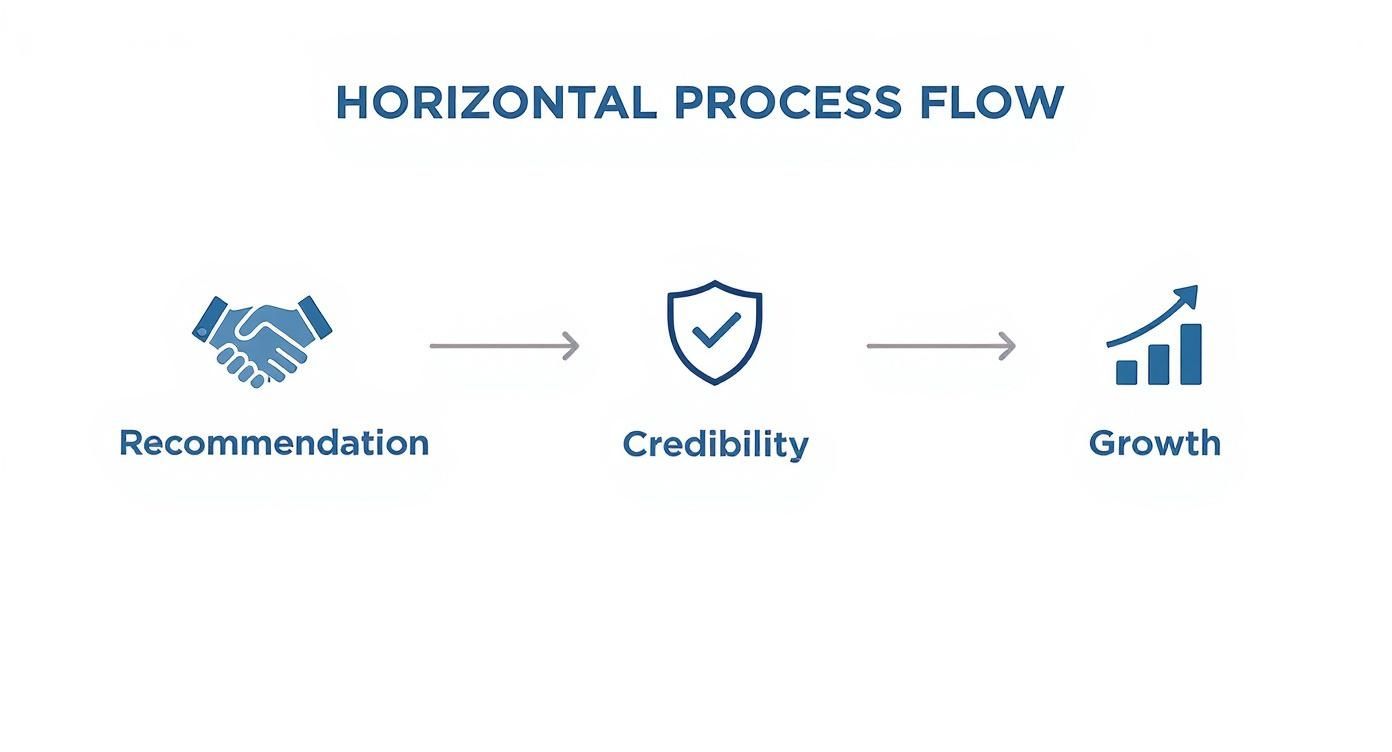
This visual gets to the heart of WOMM—authentic trust from real users is the direct catalyst for expansion. Once you've nailed the experience, you can layer on specific tactics to encourage and amplify those natural conversations.
Actively Encourage Customer Reviews
One of the simplest, most powerful ways to build social proof is to just ask for it. Happy customers are usually more than willing to share their thoughts, but they’re busy. They need a nudge. Don't leave it to chance.
Weave review requests right into your customer's journey. The perfect time to ask is immediately after a "win," like when your support team resolves an issue or after they've successfully used a key feature. Make it frictionless by sending direct links to relevant review sites like G2, Capterra, or Google.
Design Simple and Effective Referral Programs
Referral programs put a structure around sharing, creating a clear incentive for both the person referring and the new customer they bring in. But be warned: complexity is the enemy here. A program with confusing rules or a delayed payout will just collect dust.
To get this right, you need to build effective referral programs that are dead simple to understand and even easier to use.
Key Insight: The best referral programs feel like a genuine win-win. Think of Dropbox's classic program. The referrer got extra storage, and the new user also got extra storage. The incentive was tied directly to the product's value, which made sharing feel natural, not transactional.
Harness the Power of User-Generated Content
User-Generated Content (UGC) is today's testimonial. It’s raw, authentic, and incredibly persuasive precisely because it comes from real people, not your marketing department. So, encourage your users to show off how they're using your product.
Here are a few ways to do that:
- Create a branded hashtag for users to tag their posts on social media.
- Run contests or giveaways for the best photos, videos, or success stories.
- Showcase customer content on your own website and social channels (always with their permission, of course).
This approach doesn't just give you a constant flow of genuine marketing assets; it builds a real sense of community around your brand.
To see more examples of these tactics in play, check out our complete guide on word-of-mouth marketing strategies. By putting these steps into motion consistently, you can build a self-sustaining engine that drives awareness, builds trust, and fuels growth.
How to Measure What Matters in WOMM
One of the biggest hang-ups people have with word-of-mouth marketing is the belief that you can't actually measure it. It feels invisible, like trying to catch smoke. This idea stops a lot of companies from even trying, but it’s a myth. You absolutely can track the impact of WOMM; you just have to know where to look.
Tracking word-of-mouth isn't about watching a clicks dashboard. It’s about measuring what people are saying, how much influence they have, and what actions their recommendations are driving. By combining a few different metrics, you can start to paint a really clear picture of how customer conversations translate into actual business growth.
Key Metrics for Tracking WOMM Success
To prove that your WOMM efforts are working, you need to connect the dots between customer advocacy and your bottom line. These are the core KPIs that will help you track both customer sentiment and hard conversions.
Net Promoter Score (NPS): This is the classic for a reason. Asking that simple question—"How likely are you to recommend our product?"—is a powerful way to gauge customer loyalty. It helps you see who your biggest fans (Promoters) are, giving you a solid benchmark for satisfaction.
Referral Conversion Rate: This one is straightforward. Give your customers unique referral codes or send their friends to a dedicated landing page. This lets you track exactly how many of those referred visitors sign up or buy, giving you a direct line from advocacy to new revenue.
Social Mentions and Share of Voice: Fire up a social listening tool and keep an eye on platforms like X (formerly Twitter), Reddit, and LinkedIn. Tracking how often your brand pops up in conversations—and whether those conversations are positive or negative—shows you how much space you're taking up in your industry's organic dialogue.
Key Takeaway: Measuring word-of-mouth is like being a detective. You piece together clues from different places. You'll never track every single private recommendation, but you can absolutely measure the results they create, like a sudden spike in direct traffic or a higher referral rate.
Uncovering the Impact of Dark Social
A huge amount of word-of-mouth happens in what we call "dark social." Think about all the recommendations happening in private DMs, Slack channels, and text messages. You can't see the share itself, but you can absolutely see its effect.
So, how do you track it? One of the easiest and most powerful ways is to add a single, simple question to your signup or checkout form: "How did you hear about us?"
That's it. A simple dropdown menu with an option like "Friend/Colleague" will uncover the hidden engine of word-of-mouth driving your growth. This data is gold for understanding the real value of your efforts. For a deeper dive into connecting these efforts to your bottom line, check out our guide on how to calculate marketing ROI.
Common WOMM Mistakes and How to Avoid Them
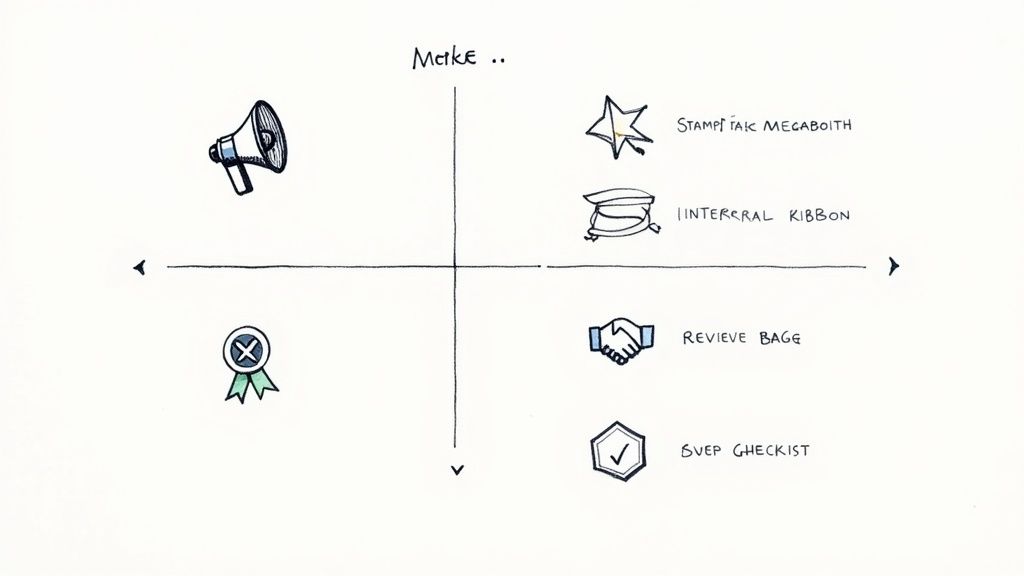
Word-of-mouth marketing is powerful, but it's also incredibly delicate. Its entire foundation is built on authenticity, and a few common missteps can easily shatter that trust and leave you with a PR headache instead of a loyal following.
The biggest, most tempting mistake? Trying to fake the buzz. Your customers are smart. They can spot a paid-for, overly incentivized, or forced testimonial from a mile away. Pushing for glowing reviews that feel scripted will do far more damage than good, poisoning the well of trust you're trying to build.
Another huge error is to ignore—or worse, delete—negative feedback. It’s a gut reaction to want to hide criticism, but it's a terrible look. Failing to respond or making negative comments disappear sends a clear signal: you don't actually care about what your customers think. That’s how you turn one unhappy person into a vocal, motivated detractor.
Forcing Complexity on Your Advocates
Even the best-laid plans can fall apart if they're a pain to use. Overly complicated referral programs are a perfect example of this. You're trying to get your biggest fans to help you out, so why make it feel like work?
If your program has too many steps, confusing rules, or a reward that never seems to arrive, you’re creating friction. People are busy. If they have to jump through a bunch of hoops to recommend your product, they just won't. The whole point is to make sharing effortless.
Key Takeaway: A referral program's success is directly tied to its simplicity. If it takes more than a minute to understand and use, it’s already too complicated for most customers.
Prioritizing Quantity Over Quality
Finally, a lot of companies fall into the trap of chasing the wrong numbers. Dangle a big cash reward for every referral, and sure, you might see a spike in sign-ups. But what kind of sign-ups are you getting?
Often, you're just attracting low-quality leads who are in it for the kickback, not because they actually need your solution. These users almost never stick around to become valuable, long-term customers and end up just draining your resources. A much better approach is to offer incentives tied to your actual product—think account credits or access to a premium feature. That way, you attract people who are genuinely interested in what you have to offer.
Got Questions About Word-of-Mouth? We've Got Answers.
Even with the best game plan, you're bound to run into some specific questions when you start putting word-of-mouth marketing into action. Let's tackle some of the most common ones that pop up.
Think of this as a quick-reference guide to clear up any confusion and help you navigate the practical side of things.
What's the Real Difference Between Word-of-Mouth and Viral Marketing?
It's easy to mix these two up, but they're fundamentally different in their goals and how they play out.
Word-of-mouth marketing is like building a strong, self-sustaining fire. It’s about creating genuine, long-term trust and authentic recommendations over time. The whole point is to build a base of loyal customers who willingly advocate for you.
Viral marketing, on the other hand, is a lightning strike. The goal is the explosive, rapid-fire sharing of one specific piece of content or a campaign. While a viral moment can absolutely spark some word-of-mouth, the end goal of WOMM is sustained advocacy, not just a short-lived burst of attention.
A viral hit gets people talking for a week; great word-of-mouth gets people talking for years. The first is an event, while the second is an outcome of consistently exceeding expectations.
How Can a Small Business Get Started with Word-of-Mouth?
You don't need a massive budget to be great at this. In fact, small businesses often have an advantage because they can be more personal. The absolute first step? Deliver a fantastic product and provide customer service that people want to talk about. That's the bedrock.
Once you have happy customers, here are a few simple things you can do:
- Just ask for reviews. Don't be shy. Actively encourage feedback on Google, Yelp, or whatever platforms matter in your industry.
- Create a simple referral offer. A small discount for the person referring and the new customer is a classic win-win that works wonders.
- Get personal on social media. Real, one-on-one interactions are free and incredibly powerful for building a tight-knit community.
Is Negative Word-of-Mouth Always a Disaster?
No one wants to see a bad review, but negative feedback is actually a golden opportunity in disguise. The real test isn't the criticism itself—it's how you respond to it publicly. Ignoring it is the worst thing you can do; it just tells everyone you don’t care.
When you respond with empathy and offer a genuine solution, you show everyone you're transparent and accountable. It can turn a bad experience into a public display of incredible customer service, building trust with potential customers who see you know how to handle things when they go wrong.
Ready to turn positive conversations into measurable growth? Replymer is a done-for-you service that finds the right discussions online and inserts your brand with authentic, human-written replies. Learn more at https://replymer.com.

